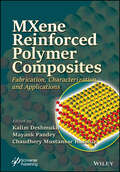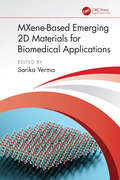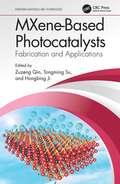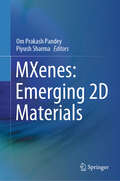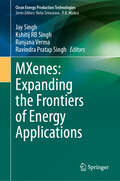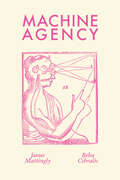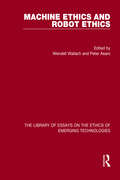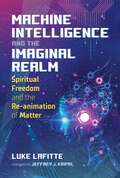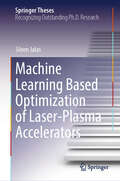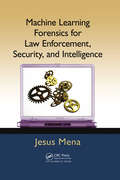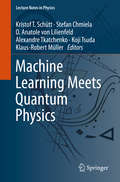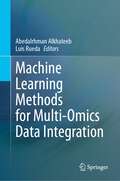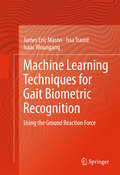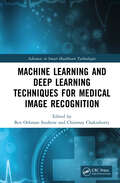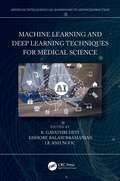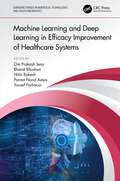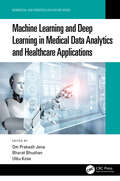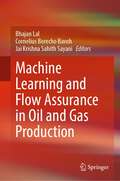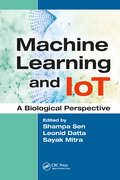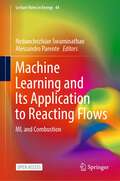- Table View
- List View
MXene Reinforced Polymer Composites: Fabrication, Characterization and Applications
by Chaudhery Mustansar Hussain Kalim Deshmukh Mayank PandeyMXene Reinforced Polymer Composites This volume is the first book to comprehensively explore the various fabrication and processing strategies for MXene-reinforced polymer composites including detailed characterizations and their numerous applications. The book systematically provides a critical discussion on the synthesis and processing methods, structure, properties, characterizations, surface chemistry, and functionalization strategies of MXenes and their utilization as efficient nanofiller into various polymer matrices to form high-performance polymer composites. The book provides a deep insight into the recent state-of-the-art progress in MXene-reinforced polymer composites, discussing several critical issues and providing suggestions for future work. The key features of this book are: Providing fundamental information and a clear understanding of the synthesis, processing, compositions, structure, and physicochemical properties of MXenes; Presenting a comprehensive review of several recent accomplishments and key scientific and technological challenges in developing MXene-reinforced polymer composites; Exploring various processing and fabrication methods of MXene-reinforced polymer composites; Providing deep insight into fundamental properties and various emerging applications of MXene-reinforced polymer/composites. Audience Researchers, postgraduates, and industry engineers working in materials science, polymer science, materials engineering, and nanotechnology, as well as technologists in electronic, electrical, and biomedical industries.
MXene-Based Emerging 2D Materials for Biomedical Applications
by Sarika VermaThis book provides a well-focused and comprehensive overview of the history and background of MXene-based materials and their structure, synthesis, properties, and modifications for making various advanced materials. It covers in-depth processing parameters for making MXene-based materials for high-end applications, especially in the biomedical and pharmaceutical fields.MXene-Based Emerging 2D Materials for Biomedical Applications examines the use of MXenes in the healthcare sector as therapeutic agents in pharmaceuticals and medicine. The book examines MXene use in diagnosis and analysis as biosensors, disease detection, gene and drug delivery, cancer therapy, bioimaging, and graphen oxide (GO)-based antibacterial materials. It also discusses its potential as a promising antioxidant and GO-based scaffold for cell culture. It provides a comprehensive introduction of advanced MXene-based materials for the biomedical field/health sector through an interdisciplinary approach of research in science and biomedical engineering. The authors indicate possible areas wherein the advanced MXene-based emerging materials can benefit combining diagnostics and therapeutic possibilities and multiplex systems, and highlights the unique and novel approach to developing advanced medical applications platforms and state-of-the-art directions for future research.This book will guide bioengineering and material science students, scientists, and researchers to plan future research in this valuable field. It is a unique book that gives broad knowledge about MXene-based advanced materials under a single umbrella and demonstrates the usefulness of MXenes in the healthcare sector in multiple ways.
MXene-Based Photocatalysts: Fabrication and Applications (Emerging Materials and Technologies)
by Zuzeng QinMXene, a two-dimensional (2D) transition metal carbide, nitride, and carbonitride, was discovered in 2011. MXene has great potential as a cocatalyst in the field of photocatalysis due to its unique properties and structure. MXene-Based Photocatalysts: Fabrication and Applications introduces readers to the fundamentals, preparation, microstructure characterization, and a variety of applications of MXene-based photocatalysts. The book is a comprehensive reference for MXene materials and provides an overview of the current literature on MXene-based photocatalysts. FEATURES Discusses preparation methods of MXenes Describes the morphology and microstructure of MXenes Offers strategies for fabricating MXene-based photocatalysts Details the reaction mechanism of MXene-based photocatalysts Covers applications in photocatalytic water-splitting, photocatalytic CO2 reduction, photocatalytic degradation, photocatalytic nitrogen fixation, and photocatalytic H2O2 production This book serves as an invaluable guide for advanced students, industry professionals, professors, and researchers in the field of materials science and engineering, photocatalysis, energy, and environmental applications.
MXenes: Emerging 2D Materials
by Piyush Sharma Om Prakash PandeyThis book focuses on the expanding market for 2D MXenes and their increasing importance in future applications. It provides a thorough understanding of MXenes and their derivatives by exploring their complex composition and chemical diversity. The book provides a thorough examination of synthesis processes, characterization methodologies, and crucial attributes, which may give significant insights for both researchers and engineers. Furthermore, the book explores diverse applications of MXenes, spanning from energy storage and catalysis to electronics and beyond, thus highlighting their vast potential in driving technological innovation. Additionally, by elucidating the current state and challenges hindering the commercialization of 2D MXenes, this resource serves as a valuable guide for navigating the path towards widespread adoption. This book is an essential resource for scientists, engineers, research researchers, and students who want to delve into the captivating realm of 2D MXenes. Its interdisciplinary approach makes it a valuable tool.
MXenes: Expanding the Frontiers of Energy Applications (Clean Energy Production Technologies)
by Ravindra Pratap Singh Kshitij Rb Singh Jay Singh Ranjana VermaThe book covers fundamental aspects, explores the synthesis, composition, and various properties of this next-generation 2D material, and provides an account of the processing and development of MXenes and MXene-based composites. This book stands out as a unique contribution, focusing on two major aspects: fundamentals and energy storage applications. It thoroughly examines notable findings and technological challenges in detail. The aim is to bridge the knowledge gap in materials science, nanotechnology, and energy storage devices. The book discusses recent developments in MXenes and MXene-based composites for energy storage, including applications in supercapacitors, hybrid-ion capacitors, batteries, point-of-care devices, hydrogen storage, nanoelectronics, catalysis, electro/photocatalysis, and biofuel devices. This book provides a complete set of knowledge about 2D materials, specifically MXenes. The book serves as an excellent reference for researchers, scientists, and engineers. Moreover, it serves as a useful guide for undergraduate, postgraduate, and Ph.D. students, as well as academicians, scientists, researchers, and industry specialists working in advanced materials science, flexible electronics, nanoelectronics, and energy storage devices.
MacMillan Science (North Carolina Edition)
by Richard H. Moyer Joanne Vasquez Jay Hackett Lucy H. DanielAn inquiry based program that introduces concepts and provides opportunities for students to work together to investigate and then communicate their ideas and discoveries to teachers and peers in Science.
Machine Agency
by James Mattingly Beba CibralicAn engaging exploration of agency that provides students with the critical tools needed to understand and participate in debates about future machines.The great promise of artificial intelligence’s evolution lives alongside an equally great anxiety. As we develop increasingly autonomous machines that do things in the world, questions about agency—distinguishing machines that can act from those that cannot—are among the thorniest we face. A concise and probing exploration of agency, this accessible textbook provides the critical, technical, and conceptual tools needed to make sense of rapid changes in what machines can do and their role in our lives. James Mattingly and Beba Cibralic begin with an examination of foundational issues: What is agency? How does it differ from mindedness, consciousness, and intelligence? Can we attribute agency to certain machines, and if so, how and why? They then examine the social and ethical implications of building ever more complex machines, including those concerning moral status and responsibility. Drawing together ideas from philosophy and computer science as well as from information theory, literature, and the history of science, Machine Agency invites students to participate thoughtfully in critical debates about future machines.• Provides a roadmap for interrogating the concept of machine agency suitable for philosophy majors and non-majors alike• Investigates the connections between developments in AI and pressing issues in analytic philosophy• Explores the social and ethical impacts of computational systems with agency Features robust end-of-chapter exercises
Machine Ethics and Robot Ethics
by Wendell Wallach and Peter AsaroOnce the stuff of science fiction, recent progress in artificial intelligence, robotics, and machine learning means that these rapidly advancing technologies are finally coming into widespread use within everyday life. Such rapid development in these areas also brings with it a host of social, political and legal issues, as well as a rise in public concern and academic interest in the ethical challenges these new technologies pose. This volume is a collection of scholarly work from leading figures in the development of both robot ethics and machine ethics; it includes essays of historical significance which have become foundational for research in these two new areas of study, as well as important recent articles. The research articles selected focus on the control and governance of computational systems; the exploration of ethical and moral theories using software and robots as laboratories or simulations; inquiry into the necessary requirements for moral agency and the basis and boundaries of rights; and questions of how best to design systems that are both useful and morally sound. Collectively the articles ask what the practical ethical and legal issues, arising from the development of robots, will be over the next twenty years and how best to address these future considerations.
Machine Intelligence and the Imaginal Realm: Spiritual Freedom and the Re-animation of Matter
by Luke Lafitte• Explores how we naturally project consciousness onto machines and how this is reflected in human culture, science, artificial intelligence, and literature • Demonstrates a direct connection between consciousness and the history of machines in American history • Looks at the contributions and influence of Grace Hopper, Richard Feynman, Philip K. Dick, Nikola Tesla, Thomas Edison, Elon Musk, David Bohm, Norbert Wiener, and Steve Jobs as well as the Nag Hammadi Gnostic gospels Humans invented and constructed machines to aid them, as far back as the Stone Age. As the machines became more complex, they became extensions of the body and mind, and we naturally began projecting consciousness onto them. As Luke Lafitte shows in detail, although machines complicate the already complicated issue of identity, because they are &“ours&” and &“of us,&” they are part of our spiritual development. In this sweeping exploration of the history of the machine as a tool, as a transpersonal object to assist human activity, and as a transitional artifact between spirits and the humans who interact with them, Lafitte examines the role that machines play in the struggle between &“spiritual man&” and &“mechanical man&” throughout history. He interprets the messages, archetypes, and language of the unconscious in the first popular stories related to mechanical men, and he demonstrates a direct connection between consciousness and the history of machines in American history, specifically between the inventors of these machines and the awakening of our imaginations and our powers of manifestation. He examines the influence of Philip K. Dick, Nikola Tesla, Thomas Edison, Grace Hopper, Richard Feynman, Elon Musk, David Bohm, and others and shows how the Nag Hammadi gospels explain how we can take back our myth and spirit from the machine. Although the term &“mechanical man&” is a catch-all phrase, Lafitte shows that the term is also a meeting ground where extra-dimensional communications between different forms of matter occur. Every machine, android, robot, and cyborg arose from consciousness, and these mechanical men, whether real or fictive, offer us an opportunity to free ourselves from enslavement to materialism and awaken our imaginations to create our own realities.
Machine Learning Applications in Medicine and Biology
by Joseph Picone Ammar AhmedThis book combines selected papers from the 2022 IEEE Signal Processing in Medicine and Biology Symposium (IEEE SPMB) held at Temple University. The symposium presents multidisciplinary research in the life sciences. Topics covered include:Signal and image analysis (EEG, ECG, MRI)Machine learningData mining and classificationBig data resourcesApplications of particular interest at the 2022 symposium included digital pathology, computational biology, and quantum computing. The book features tutorials and examples of successful applications that will appeal to a wide range of professionals and researchers in signal processing, medicine, and biology.
Machine Learning Based Optimization of Laser-Plasma Accelerators (Springer Theses)
by Sören JalasThis book explores the application of machine learning-based methods, particularly Bayesian optimization, within the realm of laser-plasma accelerators. The book involves the implementation of Bayesian optimization to fine tune the parameters of the lux accelerator, encompassing simulations and real-time experimentation. In combination, the methods presented in this book provide valuable tools for effectively managing the inherent complexity of LPAs, spanning from the design phase in simulations to real-time operation, potentially paving the way for LPAs to cater to a wide array of applications with diverse demands.
Machine Learning Control by Symbolic Regression
by Askhat Diveev Elizaveta ShmalkoThis book provides comprehensive coverage on a new direction in computational mathematics research: automatic search for formulas. Formulas must be sought in all areas of science and life: these are the laws of the universe, the macro and micro world, fundamental physics, engineering, weather and natural disasters forecasting; the search for new laws in economics, politics, sociology. Accumulating many years of experience in the development and application of numerical methods of symbolic regression to solving control problems, the authors offer new possibilities not only in the field of control automation, but also in the design of completely different optimal structures in many fields. For specialists in the field of control, Machine Learning Control by Symbolic Regression opens up a new promising direction of research and acquaints scientists with the methods of automatic construction of control systems.For specialists in the field of machine learning, the book opens up a new, much broader direction than neural networks: methods of symbolic regression. This book makes it easy to master this new area in machine learning and apply this approach everywhere neural networks are used. For mathematicians, the book opens up a new approach to the construction of numerical methods for obtaining analytical solutions to unsolvable problems; for example, numerical analytical solutions of algebraic equations, differential equations, non-trivial integrals, etc. For specialists in the field of artificial intelligence, the book offers a machine way to solve problems, framed in the form of analytical relationships.
Machine Learning Forensics for Law Enforcement, Security, and Intelligence
by Jesus MenaIncreasingly, crimes and fraud are digital in nature, occurring at breakneck speed and encompassing large volumes of data. To combat this unlawful activity, knowledge about the use of machine learning technology and software is critical. Machine Learning Forensics for Law Enforcement, Security, and Intelligence integrates an assortment of deductive
Machine Learning Meets Quantum Physics (Lecture Notes in Physics #968)
by Klaus-Robert Müller Kristof T. Schütt Stefan Chmiela O. Anatole von Lilienfeld Alexandre Tkatchenko Koji TsudaDesigning molecules and materials with desired properties is an important prerequisite for advancing technology in our modern societies. This requires both the ability to calculate accurate microscopic properties, such as energies, forces and electrostatic multipoles of specific configurations, as well as efficient sampling of potential energy surfaces to obtain corresponding macroscopic properties. Tools that can provide this are accurate first-principles calculations rooted in quantum mechanics, and statistical mechanics, respectively. Unfortunately, they come at a high computational cost that prohibits calculations for large systems and long time-scales, thus presenting a severe bottleneck both for searching the vast chemical compound space and the stupendously many dynamical configurations that a molecule can assume. To overcome this challenge, recently there have been increased efforts to accelerate quantum simulations with machine learning (ML). This emerging interdisciplinary community encompasses chemists, material scientists, physicists, mathematicians and computer scientists, joining forces to contribute to the exciting hot topic of progressing machine learning and AI for molecules and materials. The book that has emerged from a series of workshops provides a snapshot of this rapidly developing field. It contains tutorial material explaining the relevant foundations needed in chemistry, physics as well as machine learning to give an easy starting point for interested readers. In addition, a number of research papers defining the current state-of-the-art are included. The book has five parts (Fundamentals, Incorporating Prior Knowledge, Deep Learning of Atomistic Representations, Atomistic Simulations and Discovery and Design), each prefaced by editorial commentary that puts the respective parts into a broader scientific context.
Machine Learning Methods for Multi-Omics Data Integration
by Luis Rueda Abedalrhman AlkhateebThe advancement of biomedical engineering has enabled the generation of multi-omics data by developing high-throughput technologies, such as next-generation sequencing, mass spectrometry, and microarrays. Large-scale data sets for multiple omics platforms, including genomics, transcriptomics, proteomics, and metabolomics, have become more accessible and cost-effective over time. Integrating multi-omics data has become increasingly important in many research fields, such as bioinformatics, genomics, and systems biology. This integration allows researchers to understand complex interactions between biological molecules and pathways. It enables us to comprehensively understand complex biological systems, leading to new insights into disease mechanisms, drug discovery, and personalized medicine. Still, integrating various heterogeneous data types into a single learning model also comes with challenges. In this regard, learning algorithms have been vital in analyzing and integrating these large-scale heterogeneous data sets into one learning model. This book overviews the latest multi-omics technologies, machine learning techniques for data integration, and multi-omics databases for validation. It covers different types of learning for supervised and unsupervised learning techniques, including standard classifiers, deep learning, tensor factorization, ensemble learning, and clustering, among others. The book categorizes different levels of integrations, ranging from early, middle, or late-stage among multi-view models. The underlying models target different objectives, such as knowledge discovery, pattern recognition, disease-related biomarkers, and validation tools for multi-omics data. Finally, the book emphasizes practical applications and case studies, making it an essential resource for researchers and practitioners looking to apply machine learning to their multi-omics data sets. The book covers data preprocessing, feature selection, and model evaluation, providing readers with a practical guide to implementing machine learning techniques on various multi-omics data sets.
Machine Learning Techniques for Gait Biometric Recognition
by Isaac Woungang James Eric Mason Issa TraoréThis book focuses on how machine learning techniques can be used to analyze and make use of one particular category of behavioral biometrics known as the gait biometric. A comprehensive Ground Reaction Force (GRF)-based Gait Biometrics Recognition framework is proposed and validated by experiments. In addition, an in-depth analysis of existing recognition techniques that are best suited for performing footstep GRF-based person recognition is also proposed, as well as a comparison of feature extractors, normalizers, and classifiers configurations that were never directly compared with one another in any previous GRF recognition research. Finally, a detailed theoretical overview of many existing machine learning techniques is presented, leading to a proposal of two novel data processing techniques developed specifically for the purpose of gait biometric recognition using GRF. This book · introduces novel machine-learning-based temporal normalization techniques · bridges research gaps concerning the effect of footwear and stepping speed on footstep GRF-based person recognition · provides detailed discussions of key research challenges and open research issues in gait biometrics recognition · compares biometrics systems trained and tested with the same footwear against those trained and tested with different footwear
Machine Learning Technologies on Energy Economics and Finance: Energy and Sustainable Analytics, Volume 1 (International Series in Operations Research & Management Science #367)
by Mohammad Zoynul Abedin Wang YongThis book explores the latest innovations in energy economics and finance, with a particular focus on the role of machine learning algorithms in advancing the energy sector. It examines key factors shaping this field, including market structures, regulatory frameworks, environmental impacts, and the dynamics of the global energy market. It discusses the critical application of machine learning (ML) in energy financing, introducing predictive tools for forecasting energy prices across various sectors—such as crude oil, electricity, fuelwood, solar, and natural gas. It also addresses how ML can predict investor behavior and assess the efficiency of energy markets, with a focus on both the opportunities and challenges in renewable energy and energy finance. This book serves as a comprehensive guide for academics, practitioners, financial managers, stakeholders, government officials, and policymakers who seek strategies to enhance energy systems, reduce costs and uncertainties, and optimize revenue for economic growth. This is the first volume of a two-volume set.
Machine Learning and Deep Learning Techniques for Medical Image Recognition (Advances in Smart Healthcare Technologies)
by Ben Othman Soufiene and Chinmay ChakrabortyMachine Learning and Deep Learning Techniques for Medical Image Recognition comprehensively reviews deep learning-based algorithms in medical image analysis problems including medical image processing. It includes a detailed review of deep learning approaches for semantic object detection and segmentation in medical image computing and large-scale radiology database mining. A particular focus is placed on the application of convolutional neural networks with the theory and varied selection of techniques for semantic segmentation using deep learning principles in medical imaging supported by practical examples. Features: Offers important key aspects in the development and implementation of machine learning and deep learning approaches toward developing prediction tools and models and improving medical diagnosis Teaches how machine learning and deep learning algorithms are applied to a broad range of application areas, including chest X-ray, breast computer-aided detection, lung and chest, microscopy, and pathology Covers common research problems in medical image analysis and their challenges Focuses on aspects of deep learning and machine learning for combating COVID-19 Includes pertinent case studies This book is aimed at researchers and graduate students in computer engineering, artificial intelligence and machine learning, and biomedical imaging.
Machine Learning and Deep Learning Techniques for Medical Science (Artificial Intelligence (AI): Elementary to Advanced Practices)
by K. Gayathri DeviThe application of machine learning is growing exponentially into every branch of business and science, including medical science. This book presents the integration of machine learning (ML) and deep learning (DL) algorithms that can be applied in the healthcare sector to reduce the time required by doctors, radiologists, and other medical professionals for analyzing, predicting, and diagnosing the conditions with accurate results. The book offers important key aspects in the development and implementation of ML and DL approaches toward developing prediction tools and models and improving medical diagnosis. The contributors explore the recent trends, innovations, challenges, and solutions, as well as case studies of the applications of ML and DL in intelligent system-based disease diagnosis. The chapters also highlight the basics and the need for applying mathematical aspects with reference to the development of new medical models. Authors also explore ML and DL in relation to artificial intelligence (AI) prediction tools, the discovery of drugs, neuroscience, diagnosis in multiple imaging modalities, and pattern recognition approaches to functional magnetic resonance imaging images. This book is for students and researchers of computer science and engineering, electronics and communication engineering, and information technology; for biomedical engineering researchers, academicians, and educators; and for students and professionals in other areas of the healthcare sector. Presents key aspects in the development and the implementation of ML and DL approaches toward developing prediction tools, models, and improving medical diagnosis Discusses the recent trends, innovations, challenges, solutions, and applications of intelligent system-based disease diagnosis Examines DL theories, models, and tools to enhance health information systems Explores ML and DL in relation to AI prediction tools, discovery of drugs, neuroscience, and diagnosis in multiple imaging modalities Dr. K. Gayathri Devi is a Professor at the Department of Electronics and Communication Engineering, Dr. N.G.P Institute of Technology, Tamil Nadu, India. Dr. Kishore Balasubramanian is an Assistant Professor (Senior Scale) at the Department of EEE at Dr. Mahalingam College of Engineering & Technology, Tamil Nadu, India. Dr. Le Anh Ngoc is a Director of Swinburne Innovation Space and Professor in Swinburne University of Technology (Vietnam).
Machine Learning and Deep Learning in Efficacy Improvement of Healthcare Systems (Emerging Trends in Biomedical Technologies and Health informatics)
by Om Prakash JenaThe goal of medical informatics is to improve life expectancy, disease diagnosis and quality of life. Medical devices have revolutionized healthcare and have led to the modern age of machine learning, deep learning and Internet of Medical Things (IoMT) with their proliferation, mobility and agility. This book exposes different dimensions of applications for computational intelligence and explains its use in solving various biomedical and healthcare problems in the real world. This book describes the fundamental concepts of machine learning and deep learning techniques in a healthcare system. The aim of this book is to describe how deep learning methods are used to ensure high-quality data processing, medical image and signal analysis and improved healthcare applications. This book also explores different dimensions of computational intelligence applications and illustrates its use in the solution of assorted real-world biomedical and healthcare problems. Furthermore, it provides the healthcare sector with innovative advances in theory, analytical approaches, numerical simulation, statistical analysis, modelling, advanced deployment, case studies, analytical results, computational structuring and significant progress in the field of machine learning and deep learning in healthcare applications. FEATURES Explores different dimensions of computational intelligence applications and illustrates its use in the solution of assorted real-world biomedical and healthcare problems Provides guidance in developing intelligence-based diagnostic systems, efficient models and cost-effective machines Provides the latest research findings, solutions to the concerning issues and relevant theoretical frameworks in the area of machine learning and deep learning for healthcare systems Describes experiences and findings relating to protocol design, prototyping, experimental evaluation, real testbeds and empirical characterization of security and privacy interoperability issues in healthcare applications Explores and illustrates the current and future impacts of pandemics and mitigates risk in healthcare with advanced analytics This book is intended for students, researchers, professionals and policy makers working in the fields of public health and in the healthcare sector. Scientists and IT specialists will also find this book beneficial for research exposure and new ideas in the field of machine learning and deep learning.
Machine Learning and Deep Learning in Medical Data Analytics and Healthcare Applications (Biomedical and Robotics Healthcare)
by Om Prakash JenaMachine Learning and Deep Learning in Medical Data Analytics and Healthcare Applications introduces and explores a variety of schemes designed to empower, enhance, and represent multi-institutional and multi-disciplinary machine learning (ML) and deep learning (DL) research in healthcare paradigms. Serving as a unique compendium of existing and emerging ML/DL paradigms for the healthcare sector, this book demonstrates the depth, breadth, complexity, and diversity of this multi-disciplinary area. It provides a comprehensive overview of ML/DL algorithms and explores the related use cases in enterprises such as computer-aided medical diagnostics, drug discovery and development, medical imaging, automation, robotic surgery, electronic smart records creation, outbreak prediction, medical image analysis, and radiation treatments. This book aims to endow different communities with the innovative advances in theory, analytical results, case studies, numerical simulation, modeling, and computational structuring in the field of ML/DL models for healthcare applications. It will reveal different dimensions of ML/DL applications and will illustrate their use in the solution of assorted real-world biomedical and healthcare problems. Features: Covers the fundamentals of ML and DL in the context of healthcare applications Discusses various data collection approaches from various sources and how to use them in ML/DL models Integrates several aspects of AI-based computational intelligence such as ML and DL from diversified perspectives which describe recent research trends and advanced topics in the field Explores the current and future impacts of pandemics and risk mitigation in healthcare with advanced analytics Emphasizes feature selection as an important step in any accurate model simulation where ML/DL methods are used to help train the system and extract the positive solution implicitly This book is a valuable source of information for researchers, scientists, healthcare professionals, programmers, and graduate-level students interested in understanding the applications of ML/DL in healthcare scenarios. Dr. Om Prakash Jena is an Assistant Professor in the Department of Computer Science, Ravenshaw University, Cuttack, Odisha, India. Dr. Bharat Bhushan is an Assistant Professor of Department of Computer Science and Engineering (CSE) at the School of Engineering and Technology, Sharda University, Greater Noida, India. Dr. Utku Kose is an Associate Professor in Suleyman Demirel University, Turkey.
Machine Learning and Flow Assurance in Oil and Gas Production
by Bhajan Lal Cornelius Borecho Bavoh Jai Krishna Sahith SayaniThis book is useful to flow assurance engineers, students, and industries who wish to be flow assurance authorities in the twenty-first-century oil and gas industry.The use of digital or artificial intelligence methods in flow assurance has increased recently to achieve fast results without any thorough training effectively. Generally, flow assurance covers all risks associated with maintaining the flow of oil and gas during any stage in the petroleum industry. Flow assurance in the oil and gas industry covers the anticipation, limitation, and/or prevention of hydrates, wax, asphaltenes, scale, and corrosion during operation. Flow assurance challenges mostly lead to stoppage of production or plugs, damage to pipelines or production facilities, economic losses, and in severe cases blowouts and loss of human lives. A combination of several chemical and non-chemical techniques is mostly used to prevent flow assurance issues in the industry. However, the use of models to anticipate, limit, and/or prevent flow assurance problems is recommended as the best and most suitable practice. The existing proposed flow assurance models on hydrates, wax, asphaltenes, scale, and corrosion management are challenged with accuracy and precision. They are not also limited by several parametric assumptions. Recently, machine learning methods have gained much attention as best practices for predicting flow assurance issues. Examples of these machine learning models include conventional approaches such as artificial neural network, support vector machine (SVM), least square support vector machine (LSSVM), random forest (RF), and hybrid models. The use of machine learning in flow assurance is growing, and thus, relevant knowledge and guidelines on their application methods and effectiveness are needed for academic, industrial, and research purposes.In this book, the authors focus on the use and abilities of various machine learning methods in flow assurance. Initially, basic definitions and use of machine learning in flow assurance are discussed in a broader scope within the oil and gas industry. The rest of the chapters discuss the use of machine learning in various flow assurance areas such as hydrates, wax, asphaltenes, scale, and corrosion. Also, the use of machine learning in practical field applications is discussed to understand the practical use of machine learning in flow assurance.
Machine Learning and IoT Applications for Health Informatics
by Pijush Samui Zhang Wengang Sekhar Roy Sanjiban Taguchi Y HThis book brings together leading experts from around the world to explore the transformative potential of Machine Learning (ML) and the Internet of Things (IoT) in healthcare. It provides a platform for studying a future where healthcare becomes more precise, personalized, and accessible for all. The book covers recent advancements that will shape the future of healthcare and how artificial intelligence is revolutionizing disease detection, from analyzing chest X-rays for pneumonia to solving the secrets of our genes. It investigates the transformative potential of smart devices, real-time analysis of heart data, and personalized treatment plan creation. It shows how ML and IoT work and presents real-world examples of how they are leading to earlier and more accurate diagnoses and personalized treatments.Therefore, this edited book will be an invaluable resource for researchers, healthcare professionals, data scientists, or simply someone passionate about the future of healthcare. Readers will discover the exciting possibilities that lie ahead at the crossroads of ML, IoT, and health informatics.
Machine Learning and IoT: A Biological Perspective
by Shampa Sen, Leonid Datta and Sayak MitraThis book discusses some of the innumerable ways in which computational methods can be used to facilitate research in biology and medicine - from storing enormous amounts of biological data to solving complex biological problems and enhancing treatment of various grave diseases.
Machine Learning and Its Application to Reacting Flows: ML and Combustion (Lecture Notes in Energy #44)
by Nedunchezhian Swaminathan Alessandro ParenteThis open access book introduces and explains machine learning (ML) algorithms and techniques developed for statistical inferences on a complex process or system and their applications to simulations of chemically reacting turbulent flows.These two fields, ML and turbulent combustion, have large body of work and knowledge on their own, and this book brings them together and explain the complexities and challenges involved in applying ML techniques to simulate and study reacting flows. This is important as to the world’s total primary energy supply (TPES), since more than 90% of this supply is through combustion technologies and the non-negligible effects of combustion on environment. Although alternative technologies based on renewable energies are coming up, their shares for the TPES is are less than 5% currently and one needs a complete paradigm shift to replace combustion sources. Whether this is practical or not is entirely a different question, and an answer to this question depends on the respondent. However, a pragmatic analysis suggests that the combustion share to TPES is likely to be more than 70% even by 2070. Hence, it will be prudent to take advantage of ML techniques to improve combustion sciences and technologies so that efficient and “greener” combustion systems that are friendlier to the environment can be designed. The book covers the current state of the art in these two topics and outlines the challenges involved, merits and drawbacks of using ML for turbulent combustion simulations including avenues which can be explored to overcome the challenges. The required mathematical equations and backgrounds are discussed with ample references for readers to find further detail if they wish. This book is unique since there is not any book with similar coverage of topics, ranging from big data analysis and machine learning algorithm to their applications for combustion science and system design for energy generation.
